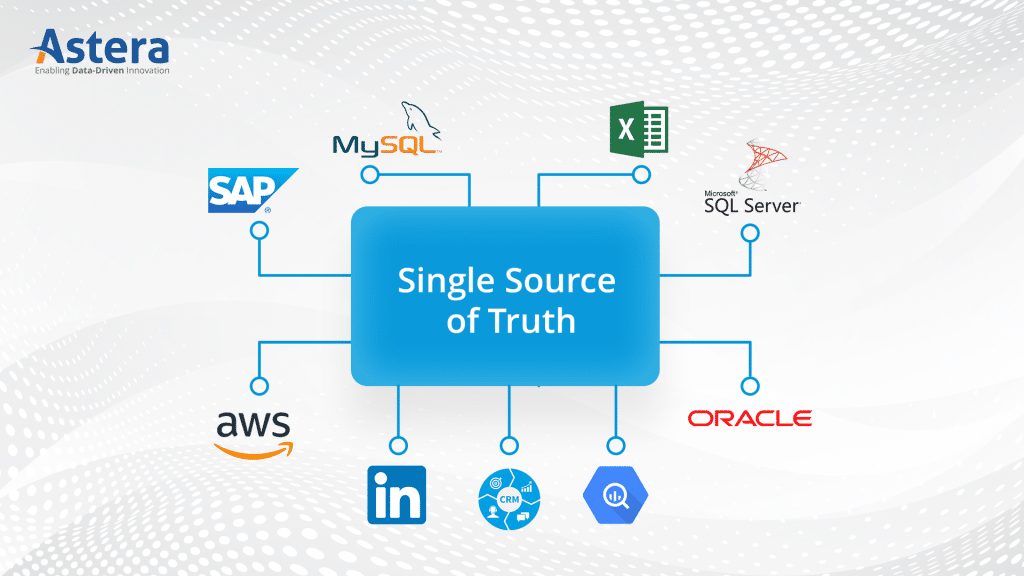In today’s data-driven world, businesses rapidly generate massive amounts of data. Managing this data effectively and timely is critical for decision-making, but how can they make sense of all this data most efficiently? The answer lies in the concept of a single source of truth (SSOT). This is the key to unlocking the potential of this data, empowering businesses to make sense of it and make accurate business decisions.
In this blog, you will find out what a single source of truth is, how it applies to enterprises, the implementation challenges, and the benefits it offers.
What is a Single Source of Truth?
Within the realm of data management, a single source of truth is a concept that refers to a centralized repository containing an organization’s most accurate, complete, and up-to-date data. This data serves as the organization’s master data and is accessible to anyone who needs it. A single source of truth serves as the centralized data repository containing the most accurate and up-to-date data.

A single source of truth serves as the centralized data repository containing the most accurate and up-to-date data.
How Does This Apply to Modern Enterprises?
Global enterprises have data scattered across different business units, and then further spread across different departments with every department having its own central repository. These repositories can be called ‘departmental’ sources of truth. Team members heavily depend on these repositories for decision-making, reporting and visualizing data, and other business intelligence activities.
So where does it leave the enterprise? With every department operating in an isolated silo, the data they base their decisions on is mostly inconsistent, inaccurate, and not up to date. This is when it becomes vital to implement a truly single source of truth. A single source of truth (SSOT) contains the master data and enables data sharing across different departments and business units.
However, to establish a single source of truth, enterprises have to combine data from different sources, which is often tedious and time-consuming. Because this data is in different formats, transforming it and improving its quality is of prime importance before loading it into a data warehouse.
Challenges of Implementing a Single Source of Truth
While a single source of truth is a necessity, there are many challenges that enterprises face in adopting it.
1. Integrating data from multiple sources
According to a survey by Market Pulse, organizations have more than 400 data sources on average. As if that’s not enough, many global businesses have data coming in from more than a thousand sources!
The data from these sources have different formats, structures, and standards, making it an arduous endeavor for data engineers and professionals. They have to ensure that the data is mapped correctly, transformed as required, and loaded into the destination without any errors.
Integrating data from these many sources is a formidable challenge on its own, and this is precisely where an automated data integration platform can help.
2. Ensuring data quality
Another major challenge is implementing robust data quality management. A single source of truth will only be as reliable as the data it contains. Because the data comes in from disparate sources and in different formats, it’s critical to set up data quality checks.
Data professionals will need to ensure that the data is accurate, complete, and consistent before it makes its way to the target destination.
3. Ensuring data security
Similar to how a single source of truth is an ongoing approach, ensuring data security is also a continuous process that requires constant monitoring to protect data from cyberattacks. Many enterprises operate in highly regulated industries where data security is of utmost importance, such as healthcare and finance.
While implementing a single source of truth, enterprises must ensure that they comply with all the required regulations like HIPAA, GDPR, etc. Because the data is available across the enterprise, these regulations require organizations to keep a strict control over their data assets. This includes setting up and managing access controls so that every person only accesses the data they need to perform their tasks.
4. Gaining stakeholder buy-in
Getting buy-in from stakeholders on a new process, system, or approach that will impact their day-to-day operations is another major challenge. Similarly, implementing a single source of truth will mean that departments will have to change the way they work which also involves changing the processes and systems that the stakeholders are used to.
Therefore, it is important to communicate and reiterate the incredible benefits of these changes.
Benefits of a Single Source of Truth
Enterprises deal with formidable challenges in pursuit of a single source of truth, but once it’s implemented, it offers numerous benefits. These include:
1. Breaks down data silos
One of the biggest benefits of creating a single source of truth is that it eliminates data silos. Instead of being scattered across the enterprise, the most accurate and up-to-date data is available in a centralized location.
2. Eliminates redundant data
When different teams work with different sources of data, it leads to data redundancy and errors. A single source of truth, on the other hand, eliminates redundancy and guarantees data accuracy, enabling teams to make more informed decisions.
3. Increases collaboration and productivity
A single source of truth means that every team uses the same data source for decision-making, reporting, or other BI initiatives. This further enables teams to collaborate more effectively since everyone has the same data set to work with. Needless to say, effective collaboration leads to higher levels of productivity.
4. Promotes transparency
Another advantage of having a single source of truth is that it builds and promotes the culture of transparency across the enterprise. Everyone with the same access level can access the same data to work with. Furthermore, it enables teams to monitor how their efforts contribute to the overall organizational goals.
How does a Modern Data Integration Platform fit in?
By incorporating a modern data integration platform, such as Astera Centerprise, into their data stacks, enterprises can effectively deal with most of the challenges they face in implementing a single source of truth.
Astera Centerprise is a no-code data integration platform powered by automation. It accelerates the process of combining data from multiple sources into a single repository, empowering enterprises to make faster, more informed decisions.
Here’s why enterprises like to use Astera Centerprise:
- Native connectors: With a wide range of native connectors, combining data from multiple sources is just a matter of point and click
- Data quality: Astera Centerprise offers advanced data quality features to ensure your single source of truth is powered by healthy data
- Ease of use: Astera’s intuitive, drag-and-drop UI makes it easy for users to build ETL/ELT pipelines without writing a single line of code
- Automation: Build data pipelines once and use job scheduler and workflow orchestration to automate the data integration process
If your enterprise is considering to build a single source of truth, call +1-888-77-ASTERA to talk to one of our data integration experts or download a 14-day free trial and get started today!





